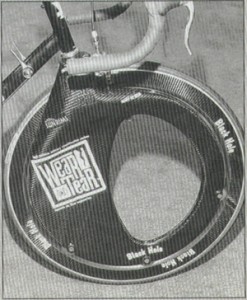 As I mentioned in a recent post, hubless wheel concept bikes have been appearing on the web in droves lately. Fast Company recently featured a few of those recent concept bikes (and one really old one) in their “Almost Genius” category, reserved for designs that don’t quite work. On the Core77 discussion boards, slippyfish recently started, “The Official Hubless Wheel Hater Thread”. One of the posts on that thread even points a pretty entertaining gallery of late 19th century hubless monocycles. Of course, BSNYC’s “save the hubs” campaign gets a mention too. All in all, it seems that everyone is kind of tired of seeing new hubless wheel concepts on the web every week.
As I mentioned in a recent post, hubless wheel concept bikes have been appearing on the web in droves lately. Fast Company recently featured a few of those recent concept bikes (and one really old one) in their “Almost Genius” category, reserved for designs that don’t quite work. On the Core77 discussion boards, slippyfish recently started, “The Official Hubless Wheel Hater Thread”. One of the posts on that thread even points a pretty entertaining gallery of late 19th century hubless monocycles. Of course, BSNYC’s “save the hubs” campaign gets a mention too. All in all, it seems that everyone is kind of tired of seeing new hubless wheel concepts on the web every week.
What better time to revisit a couple of old posts about a hubless wheel, which (I believe) actually went into production for a short time in the mid 90s. The picture you see above is an early prototype of the Black Hole hubless wheel system from “Wear and Tear”. According to the company, this assembly weighed about a pound less than a conventional fork and wheel. Sounds great…why didn’t it catch on?
 To the left, you can see a later prototype of the Black Hole. Obviously, the designers were a little too optimistic with that large opening in the previous prototype. I am not sure what happened to Wear and Tear, but I have my doubts that this later prototype was lighter than the average conventional fork and wheel that was available at the time.
To the left, you can see a later prototype of the Black Hole. Obviously, the designers were a little too optimistic with that large opening in the previous prototype. I am not sure what happened to Wear and Tear, but I have my doubts that this later prototype was lighter than the average conventional fork and wheel that was available at the time.
Update 3/17/10: Damon Rinard has better pictures of the Black Hole in his Flickr photostream.
On an unrelated note, the Taipei International Cycle Show opens tomorrow. As he did last year, Eric Stoddard will be writing a guest post or two from the show. I’m looking forward to reading what he has to say.

Leave a Reply to Rude dog Cancel reply